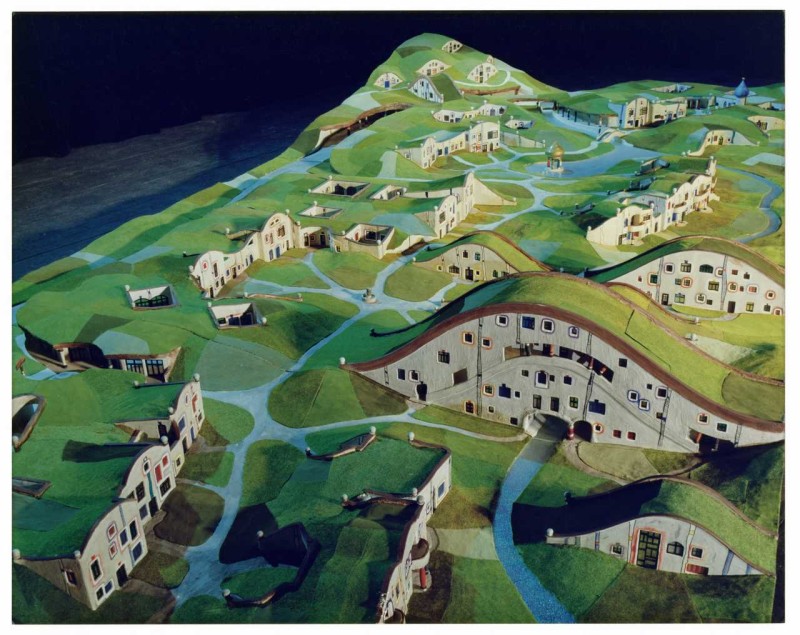Housing project for Hermelinweg (Hermelinweg-Siedlungsprojekt), 1220 Vienna for WIBEBA:
Project study by architect Peter Pelikan, on the initiative of builder Wolfgang Prinz
with preliminary plans 1:200; construction plan of an accomodation unit 1:50, 1986
Hundertwasser Manifesto: Das Hügelwiesenland - In the meadow hills (written as "Die Wald- und Wiesendachsiedlung in Wien XXII", March 5, 1987)
Architecture model 1:50: Atelier Alfred Schmid, 1989
Further development of the concept for a new site at the Kirschenallee estate, Vienna XXII, 1990/91, for the Vienna immigration fund (Wiener Zuwandererfonds)
Hundertwasser has been working since 1984 on the idea of a housing development which he originally conceived as an allotment-garden-type, two-storey development full of nooks and crannies with a wide variety of dwelling units. The roofs were to be used as vegetable gardens, meadows and forest landscape. Possible sites for such a housing development were the northern districts of Vienna. Hunderwasser wanted to combat the overdevelopment of the landscape by private homes or straight-edged row-house developments. By having meadows and forests on the hilly roofs he wanted to create new space for nature, despite the development.
In 1987 the Vienna construction company WIBEBA commissioned a project study for the project of a housing development on Hermelinweg. In 1989 a model of "In the Meadow Hills" was built on basis of Peter Pelikan's plans. Hundertwasser's models of the Seventies were further developed. The Vienna development was not realised, not least because of the opposition of a citizens' actions group, which feared disturbances in the residential area from hordes of tourists.
It wasn't until Hundertwasser was commissioned by Robert Rogner to design the Hot Springs Village for Blumau that he got a chance to turn the exemplary construction in harmony with nature into reality.
(see also: Hundertwasser Architecture, Cologne, 1997, p. 236)
- R. Schediwy, Hundertwassers Häuser, Vienna, 1999, p. 244
- A. C. Fürst, Hundertwasser 1928-2000, Catalogue Raisonné, Cologne, 2002, Vol. II, pp. 1263/1264 (and c)
- Hundertwasser Architektur, Cologne, 2006, pp. 252, 313
- Panorama, Raum und Zeit, Bern, 2005, p. 53 (c)
- E. De Luca: WIEN modern. Architektur - Design - Style, Vienna: Pichler Verlag, 2010, p. 109 (c)

Hundertwasser's comment on the work
In the Meadow Hills
1. an increase of nature as an answer to overdevelopment in the landscape
2. life in harmony with nature
3. forest and meadow instead of "concrete air"
4. the longing for romanticism and creativity is fulfilled
5. totally green houses that can be walked upon
6. energy-saving houses, latently cool in summer, warm in winter
7. waste water and rainwater are purified in a natural way and are thus given back to nature as pure as the water was received
8. granting of window rights
9. more quality of life for the neighbours, not just for the residents
10. an Austrian way out of the cul-de-sac of city planning which will be a precedent worldwide
(from Hundertwasser's manifesto "In the Meadow Hills", 1989)
(from: Hundertwasser 1928-2000, Catalogue Raisonné, Vol. 2, Taschen, Cologne, 2002, p. 1264)